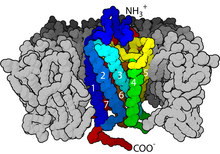细胞表面受体
细胞表面受体(cell surface receptor),是一类位于细胞表面的受体。细胞表面受体可以接收来自细胞外的信号,即与可以配对的配体结合,引发细胞内部的反应,最后产生特定的效应。这个效应可能仅在短时间内持续,比如细胞代谢或运动上的改变。也可能是长时间持续的,比如说使特定基因的表达上调[1][2]。总的来说,已发现的较经典细胞表面受体包括:G蛋白偶联受体(G protein-coupled receptor)、受体酪氨酸激酶(Receptor tyrosine kinases)、鸟苷酸环化酶偶联受体(Guanylate cyclase-coupled receptor)、离子通道(ion channel),以及黏附受体(adhesion receptor),其中以G蛋白偶连受体的数量最多[1][3]。

参见
编辑参考
编辑- ^ 1.0 1.1 Harvey Lodish; et al. Chapter 15. Molecular Cell Biology (7th edition). Macmillan Higher Education. 2013: 674–683. ISBN 978-1-4641-0981-2.
- ^ Functions of Cell Surface Receptors. The Cell: A Molecular Approach 2nd. NCBI. 2000 [2018-05-20]. (原始内容存档于2021-04-21).
- ^ David L. Nelson; Michael M. Cox; et al. Lehninger Priciples of Biochemistry 6th. New York: W. H. Freeman and Company. 2013: 436-484. ISBN 978-1-4292-3414-6.